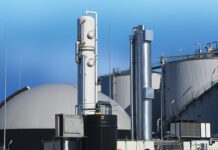
This article contains paid for content produced in collaboration with Hamamatsu.
Non-dispersive infrared (NDIR) gas measurement may be the solution for you. With infrared spectroscopy at its core, this technology can detect specific gases by analyzing their absorption wavelengths in the infrared spectrum.
Infrared spectroscopy is a powerful analytical technique that has revolutionized the fields of chemistry, biology, and materials science. By measuring the vibrations of atoms in molecules, infrared spectroscopy can provide unique insights into the chemical composition, structure, and bonding properties of a wide range of materials. Non-dispersive infrared (NDIR) gas measurement is an important application of infrared spectroscopy that has found widespread use in environmental monitoring, industrial safety, and scientific research.
NDIR gas measurement relies on the fact that different gases absorb infrared radiation at specific wavelengths, creating a unique spectral fingerprint that can be used to identify and quantify the gas present in a sample. This technique is particularly useful for detecting air pollutants emitted from various sources, such as power plants, factories, and transportation. By monitoring the levels of gases such as carbon monoxide, carbon dioxide, sulfur dioxide, nitrogen oxides, and methane, NDIR gas detectors can help to ensure that air quality standards are met and public health is protected.
The basic design of an NDIR gas detector consists of a gas chamber, a light emitter, and a detector. The gas chamber contains the sample to be analyzed, while the light emitter emits infrared radiation of a specific wavelength that is absorbed by the gas molecules. The detector measures the amount of radiation that is transmitted through the sample and compares it to the amount of radiation that would be transmitted through a reference sample with no gas present. By analyzing the difference between the two signals, the detector can determine the concentration of the gas in the sample.
While NDIR gas detectors offer many advantages over traditional gas sensing methods, they also face several challenges that must be overcome to ensure accurate and reliable measurements. One of the most significant challenges is interference from water vapor, which can absorb infrared radiation at the same wavelengths as many gases of interest. To address this issue, NDIR gas detectors often use light sources that emit in the mid-infrared range, where water absorption is much lower. Additionally, NDIR gas detectors must be carefully designed and calibrated to account for variations in temperature, power supply, and other factors that can cause signal drift over time.
Overall, NDIR gas measurement is a powerful technique that has proven useful in a wide range of applications. By providing accurate and reliable measurements of air pollutants and other gases of interest, NDIR gas detectors can help to ensure that public health and the environment are protected. While this technique does face some challenges, ongoing research and development are helping to overcome these obstacles and improve the performance of NDIR gas detectors in a variety of settings.
Discover the principles of NDIR spectroscopy principles, the typical NDIR gas detector design, and several precautionary measures that can be utilized to mitigate the most common challenges faced by this detection technique.
Click here to learn more.






